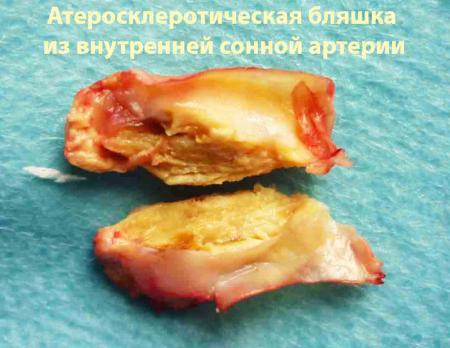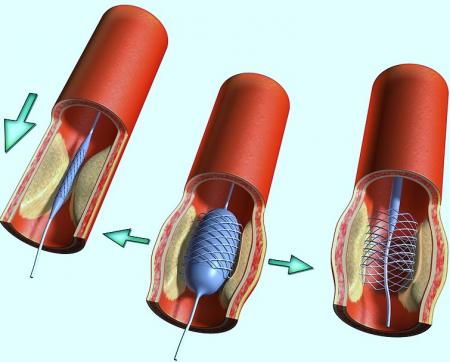Atherosclerotic vascular disease is becoming one of the main causes of death in the developed countries of the world. The reasons for this are poor nutrition, lack of physical activity and a lot of bad habits. Many patients with pain in the heart do not even suspect that it is aortic atherosclerosis, and continue to drink useless drugs. The question of how to treat atherosclerosis has come to the fore for doctors, so at the moment several progressive conservative and surgical methods for treating pathology have been developed.
Principles of treatment of the disease
When treating atherosclerosis, it is important to adhere to several principles that will help you achieve a positive result faster. Among the fundamental principles we note the following:
- limiting the use of foods high in cholesterol;
- active removal from the body of both cholesterol itself and its decay products;
- estrogen therapy in women during menopause.
Compliance with these rules significantly improves the prognosis for the effectiveness of drug therapy in patients with varying degrees of vascular atherosclerosis.
Medical treatment
Among the drugs against atherosclerosis, doctors use several main groups of drugs. They differ in direction, level of impact on the body. It is also worth noting that all groups of drugs have side effects, so they can only be used as prescribed by the attending physician, who will select the optimal drug for the treatment of pathology.
- Nicotinic acid and derivatives of this substance are actively used in the treatment of pathology. With the help of these drugs, you can achieve a significant reduction in cholesterol and triglycerides in the blood. Nicotinic acid blocks the process of lipolysis - the release of fatty acids from tissues and their entry into the general bloodstream. Means with nicotinic acid help to increase high-density lipoproteins - the so-called. "good" cholesterol needed by the body. It rises by an average of 30 percent. Also, nicotinic acid can lower blood pressure, which often affects people with atherosclerosis. This happens due to the strengthening of the walls of blood vessels and their expansion. The peculiarity of prescribing drugs of this group is that they cannot be taken by people suffering from liver diseases (can provoke fatty hepatosis), stomach ulcers. The most famous is Niacin.
- Fibrates are drugs that reduce the body's production of its own fats. As studies show, the human body in the current conditions receives enough fat from food, so there is no urgent need to produce its own lipids. With a moderate decrease in this function, the body not only does not suffer, but evens out the lipid balance. An example of such drugs is Clofibrate. The only drawback of this group of drugs is the negative effect on the liver and the possibility of cholelithiasis. Fenofibrate is an effective tool to treat cerebral atherosclerosis.
- Bile acid sequestrants are substances that bind bile acids into chemical compounds and are excreted by the body. Thus, the body manages to get rid of a certain amount of fat and cholesterol. The main disadvantage of such drugs is the appearance of flatulence or constipation in patients while taking flatulence. Popular drugs in this group are Colestipol, Tribusponin, Polisponin, Cholestyramine, Leskol,.
- Statins are the most advertised group of drugs, but also the most effective in relation to pathology. Statins reduce the production of your own cholesterol. Common drug names are Simvastatin, Pravastatin, Lovastatin, Atorvastatin, Cardiostatin and others.
Effective representatives of the statin group for the treatment of pathology
In addition to drugs that are used to lower cholesterol levels in the body, restoring the normal functioning of blood vessels is important for the treatment of atherosclerosis.
It is impossible to cure atherosclerosis without normalizing blood circulation, since the vessels must recover as much as possible after the pathology.
For such therapy, there is also a list of drug groups that determines how to treat vascular pathologies. Among them are patients. Medications are individually selected taking into account the violations that have arisen during the course of atherosclerosis:
- vasodilators - a group of drugs aimed at increasing the lumen of blood vessels for maximum blood supply. Restoring full blood circulation is extremely important, because with atherosclerosis, part of the cells received less oxygen and nutrients. Also, an increase in the lumen allows you to adjust blood pressure, relieve additional stress on the heart. Among the well-known drugs are Papaverine, No-Shpa, Nikoshpan, Galidor and others;
- drugs that affect the peripheral nervous system are prescribed to regulate the nerve impulses responsible for muscle tone. When removing muscle tone, it is much easier to restore blood circulation in vessels previously affected by atherosclerosis. Preparations of this group - Diprofen, Mydocalm, Beznotol, Andekalin and others;
- vitamin preparations, especially from group B, improve metabolic processes in cardiac tissues, help strengthen the immune system, are indicated for ischemia and trophic disorders. With the help of vitamin B2, regenerative processes are actively stimulated, vitamins B6 and B12 improve the metabolism of phospholipids in the blood. Vitamins A and E are powerful antioxidants, and vitamin F prevents the formation of cholesterol plaques and is thus the best way to prevent atherosclerosis;
- drugs from the group of angioprotectors are actively involved in intravascular lysis and prevent the formation of blood clots, which is very important for a patient suffering from atherosclerotic vascular lesions. Angioprotective drugs are Prodectin, Anginin, Liparoid, Parmidin, Andecalin, which are available both in tablet form and in the form of injections;
- antiplatelet drugs to improve blood microcirculation - Reopoliglyukin, Teonikol, Trental, Curantil, etc .;
- anticoagulants - drugs that reduce blood clotting are prescribed to patients with severe hypercoagulability. With hypercoagulation, there is a high probability that the thrombus formed in the vessel will not resolve on its own and with the blood flow can reach a narrow section of the blood vessel and clog it. In this case, the tissue site will suffer from a lack of oxygen and nutrients. If the cerebral vessels are clogged, the patient may have a stroke;
- Separately, it is worth highlighting the drug Vasoprostan, which can be used to treat atherosclerosis of the vessels of the lower extremities. The agent has a unique anti-sclerotic effect, activates the resorption of blood clots, improves metabolism in tissues that have undergone ischemia. Obliterating atherosclerosis with Vasoprostan is treated with courses using other drugs.
Surgery
Whether it is possible to cure atherosclerosis by conservative methods is of interest to many patients. Indeed, with early diagnosis, rejection of bad habits and effective treatment, atherosclerosis can be overcome without surgery. Surgery for atherosclerosis is delayed until the risk of arterial occlusion by a cholesterol plaque or blood clot develops. This occurs due to a sharp narrowing of the blood vessels and becomes deadly to the patient's life. If an atherosclerotic plaque is found in any part of the blood vessel, then this is not a reason for immediate surgical intervention.
In this case, doctors will conduct conservative treatment to reduce the deposit, establish the maximum possible blood circulation in this area and eliminate the symptoms of atherosclerosis. The operation is performed in almost one hundred percent of cases, if the atherosclerotic deposition in the vessel blocks the nutrition and oxygen supply to the brain and heart muscle. In these situations, doctors do not advise delaying surgical intervention, because at any time the vessel can become clogged with a thrombus, which can lead to death.
Surgery for a patient with atherosclerosis becomes a significant burden, so doctors carefully study all the indications for surgery and try to make it as safe as possible for the patient's life. All operations are performed under general anesthesia, patients undergo a postoperative rehabilitation course of therapy. The choice of a clinic where to treat atherosclerosis should be stopped at specialized hospitals and medical centers.
If intervention in the artery is necessary, two types of surgery are performed:
- endarterectomy - open intervention on the vessel;
- endovascular surgery - remote work of the surgeon at the site of the problem.
An endaretrectomy procedure is performed to remove the wall of an artery containing cholesterol deposits, calcium deposits, and fibrous tissue. During the surgical intervention, the doctor makes an incision in the affected area, clamps the vessel and scrapes out deposits on the vessel wall. After that, the lumen of the vessel expands significantly, blood flow improves. This technique, despite the need for more difficult penetration to the vessel, is in many cases more effective than other methods of treating atherosclerosis. In some cases, surgeons combine endarterectomy with bypass or other techniques.
Endarterectomy
Usually, endarterectomy is used in the treatment of atherosclerosis of the carotid arteries; therapy of the lower extremities, renal artery, and iliac vessels will also be rational. Preparation for the operation is carried out according to standard protocols - before the intervention, the place where the atherosclerotic plaque is localized is determined, patients are given blood thinners, standard studies are performed (duplex scanning, magnetic resonance angiography, contrast angiography).
During the operation, the blood circulation in the affected vessel is blocked, an incision is made on it, and cholesterol deposits on the walls of the vessel are scraped out with special tools. After the procedure, the vessel is sutured, blood circulation in it is restored.

Cholesterol deposits from the carotid artery removed by endarterectomy
The operation usually gives good results, but not all patients suffering from atherosclerosis are allowed to perform it. Intervention is contraindicated in malignant neoplasms, diabetes mellitus, angina pectoris, hypertension, heart failure, progressive pathologies of the brain. The operation is also contraindicated for those who have become a victim of a heart attack in the last six months. The operation is possible some time after the rehabilitation therapy.
After the operation, patients are observed in intensive care during the first day, and then transferred to the general ward. The sutures usually heal without complications. A month later, a repeated consultation with a cardiac surgeon and duplex scanning are necessary.
The most dangerous complication after the endarterectomy procedure is the development of myocardial infarction. Doctors insist on immediately contacting the clinic after the operation, if the patient has:
- severe weakness;
- pain behind the sternum in the region of the heart;
- feeling of numbness of the limbs;
- problems with speech, vision;
- difficulty breathing.
The risk of complications varies from one to three percent, so the operation of endarterectomy is considered one of the most successful methods of combating atherosclerosis.
Endovascular treatment of pathology
The procedure for endovascular treatment of atherosclerosis begins with a puncture of the femoral artery as the most convenient for the surgeon. A catheter is placed in the artery and arteriography is performed, in which it is possible to determine the degree of narrowing of the vessel and the localization of cholesterol deposits. A special metal string with a soft tip is passed through the affected area. A balloon-catheter on a string is inflated to a certain size and thereby expands the narrowed lumen of the vessel.
Such inflation of the vessel with air is carried out several times. During the procedure, the balloon is in such contact with the wall of the vessel that the cholesterol plaques are subjected to pressure, flatten out and adhere more tightly to the walls of the vessels. Due to the procedure, the lumen of the vessel expands significantly, and blood flow improves. If the occlusion of the vessel persists, doctors place a stent to support the walls of the vessels in the required size.

Balloon at the site of cholesterol plaque formation
After atherosclerosis is eliminated and blood flow is restored, all instruments are removed, and the wound is sutured or simply pinched with a finger. Usually, patients do not spend a long time in the clinic and continue their treatment at home. Complications after the procedure are extremely rare, and are associated with the formation of a bruise in the area of the puncture.
Shunting
If atherosclerosis of the aorta of the heart is diagnosed, then in this case the patient is at risk of a heart attack. This pathology is eliminated by shunting. Shunting is often used for ischemia of the heart, which is the result of atherosclerosis. The heart experiences a significant lack of oxygen and nutrients. If its main vessel - the aorta - has cholesterol deposits on its walls, then the heart is no longer fully provided with the necessary substances.
The peculiarity of shunting is that a bypass path for blood flow is formed, bypassing the problem area. For shunting, both your own healthy vessel and a prosthesis can be used.
Before treating aortic atherosclerosis surgically, standard tests are performed that are performed on cardiological patients - an electrocardiogram, coronary angiography, and an ultrasound examination of the heart. Usually, doctors prefer to use a site of the femoral vessel that has a wide lumen to form a bypass.
The operation time is about two hours.
During this time, a shunt is installed for the patient, the heart is started and the blood supply is checked. With a successful outcome of the treatment, the patient is observed for some time in the intensive care unit and then transferred to the general ward. The average hospital stay is about ten days. With such operations, the percentage of a positive outcome of treatment is high, so you should not be afraid of bypass surgery - for many difficult patients, bypass surgery is the only chance to save a life.
With proper rehabilitation, complications practically do not occur. Only a small percentage of patients experienced an increase in blood pressure, deep vein thrombosis and impaired renal function.
Alternative treatments
An atherosclerotic vessel can be cured not only by traditional methods, but also with the help of traditional medicine. Atherosclerosis has been known to the world for a long time, so our ancestors also had drugs against this pathology in their arsenal.

Onions with honey - "heavy" artillery in the fight against atherosclerosis
It is possible to treat atherosclerosis with folk remedies only with the permission of a doctor. Usually, doctors advise using alternative methods for the treatment of the initial stage of atherosclerosis, when the occlusion of the vessel is insignificant and there is no risk of rapid progression of the disease. Here are some effective recipes for remedies that will help rid the body of "bad" cholesterol:
- tincture of birch buds - one teaspoon of dried birch buds is poured into a glass of water and boiled for a quarter of an hour. Then you need to leave the product for an hour to cool naturally, then strain from the cake. The remedy is taken in half a glass four times a day;
- tincture of hawthorn flowers - one teaspoon of dried hawthorn flowers is poured into a glass of water, brought to a boil over a fire and simmered for 15 minutes. Then the product is closed with a lid and should stand for another hour. After that, the liquid is filtered and drunk in half a glass twice a day before meals;
- tincture of buckwheat color - one tablespoon of buckwheat flowers is brewed with two cups of boiling water and tightly sealed with a lid. So the liquid needs to withstand a couple of hours. Drinking a healing agent is recommended for half a glass four times a day, with high pressure against the background of atherosclerosis, you can add marsh cudweed grass to the mixture;
- elecampane root will be an excellent remedy against atherosclerosis obliterans. To prepare the product, you will need 30 grams of elecampane roots and a bottle of vodka. The roots of the plant are crushed and poured with vodka. The mixture is left in a dark place for forty days. After the expiration date, drink 25 drops of the medicine before meals. Populists especially recommend this remedy to those patients who suffer from atherosclerosis of the vessels of the brain;
- strawberries will be an excellent assistant in the fight against atherosclerosis of the vessels of the legs. The dried root of the plant is crushed and one teaspoon is poured into a glass of water. Strawberry leaves are also added here - two teaspoons. The agent is boiled for 20 minutes, and then insisted for another two hours. It is necessary to take 50 ml four times a day;
- onion juice is also useful in atherosclerosis. It must be consumed with honey. The ingredients are taken in equal proportions and mixed until a homogeneous mass. Take three tablespoons of the mixture per day;
- onions with sugar also do an excellent job with atherosclerosis. To do this, you need to grate one hundred grams of onions so that the head gives juice, and pour the gruel with a glass of sugar. You need to insist on the remedy for four days, after which it is recommended to take a tablespoon four times a day.
When treating folk remedies, it must be remembered that atherosclerosis is a serious vascular pathology that threatens human life. Not in all cases, folk methods can overcome the disease. In order not to aggravate the disease and not miss the precious time for treatment, folk remedies are used under the supervision of a doctor.
Atherosclerosis of vessels affects them anywhere. The most dangerous for human life are cholesterol plaques that impede blood circulation in the brain and heart. To treat the disease, doctors use various methods that, with timely treatment, give positive results.














